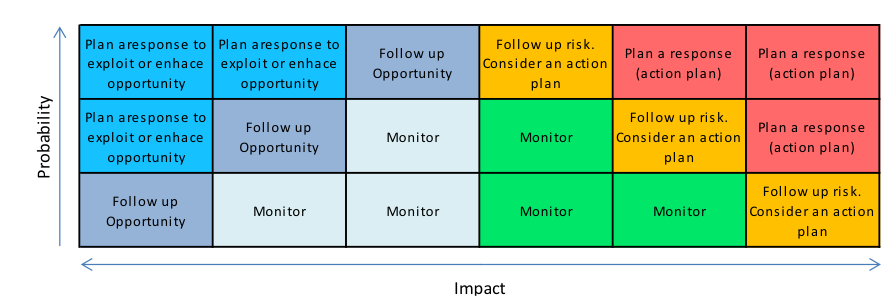The aeronautical industry is one of the most complex industries that exists. It is also one of the industries which involves the most risks due to the substantial number of countries in which it is carried out, its diverse production methods, the relationship between governments and the industry and a variety of other factors.
The main tool to conduct an analysis of any risks and opportunities identified is a probability and impact matrix.
Risk and opportunities management provides a method to identify, assess and reduce uncertainty in a structured way across all areas of an organisation (finance, sales, production, etc.). These uncertainties can have either a negative (risks) or positive (opportunities) impact on the objectives of the project or activity we are analysing. We therefore have to manage them by accepting, mitigating, transferring or eliminating risks and accepting, improving, taking advantage of and sharing opportunities.
There are a large number of techniques to identify risks and opportunities, some of the main ones being DAFO analyses, diagramming techniques and expert opinions. It is always advisable to be assisted by risk management specialists who know how to differentiate between risks and problems, help define the causes and consequences of any risks or opportunities that are identified and also take part in their subsequent analysis and categorisation.
The main tool to conduct an analysis of any risks and opportunities identified is a probability and impact matrix. It helps us set priorities based on the probability of their occurrence and the impact they may have on the objective of the project/activity we are analysing. We can thus differentiate minor risks and opportunities (acceptable) from more significant risks and opportunities, concerning which we will have to take actions which are more or less urgent.
 In order to locate a risk or opportunity within the matrix, we have to analyse, on the one hand, the probability that the uncertainty identified will turn out to be real by, for instance, assessing it as a low, moderate or high probability. This value is annotated along the matrix’s Y axis. On the other, we also have to independently assess the impact on the objective of the project or activity, which is classified, as in the case of probability, as moderate or high and annotated along the matrix’s X axis.
In order to locate a risk or opportunity within the matrix, we have to analyse, on the one hand, the probability that the uncertainty identified will turn out to be real by, for instance, assessing it as a low, moderate or high probability. This value is annotated along the matrix’s Y axis. On the other, we also have to independently assess the impact on the objective of the project or activity, which is classified, as in the case of probability, as moderate or high and annotated along the matrix’s X axis.
The combination of both assessments (probability and impact) will provide us with information about the risk’s seriousness and therefore the way to deal with it.
We all manage risks on a day-to-day basis like, for example, when we take out a home or automobile insurance police, make a decision on where and when to go on a trip or each time we have to take an important decision affecting our personal or professional lives. Risk Management provides us with the tools and rules to ensure that such management is more effective and efficient. It also helps us to avoid future problems in the case of threats or to take full advantage of opportunities.



